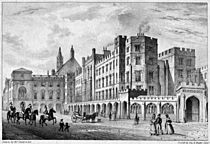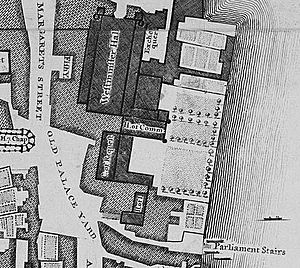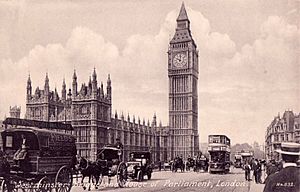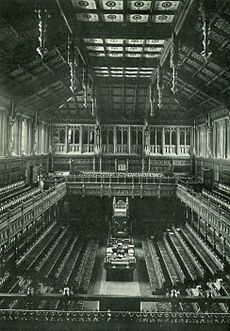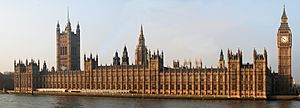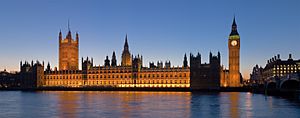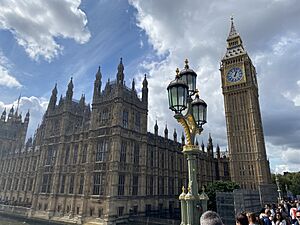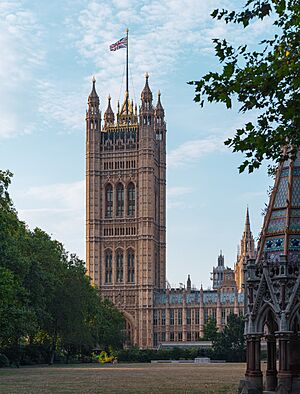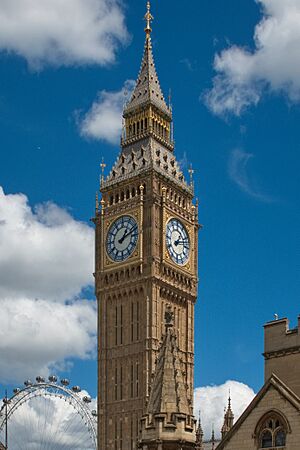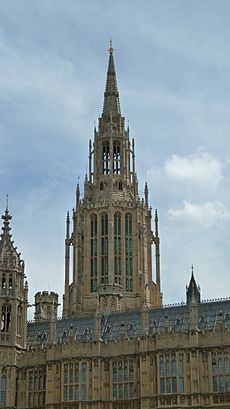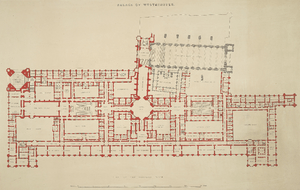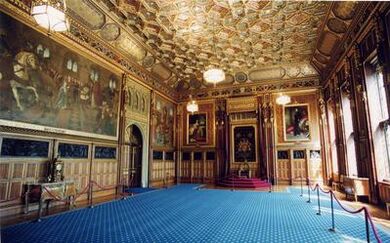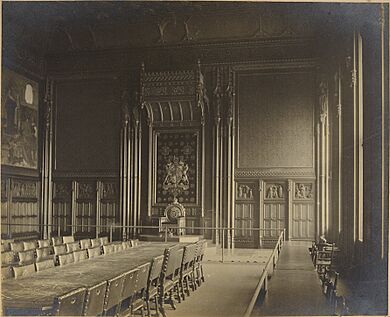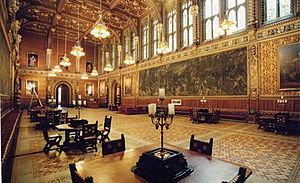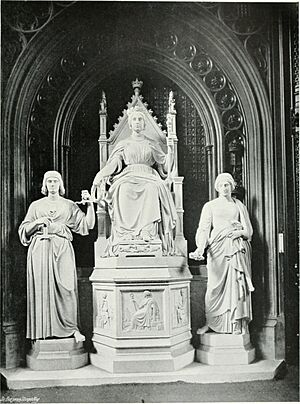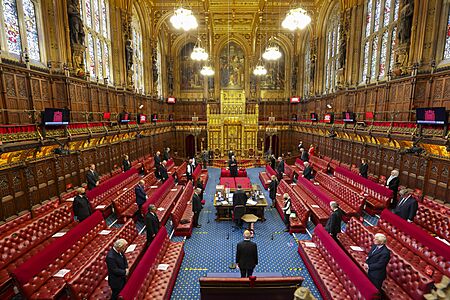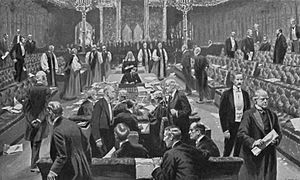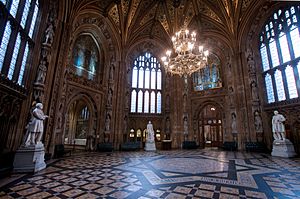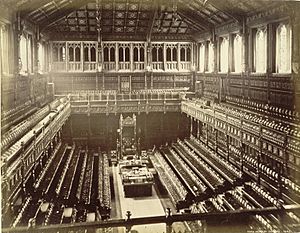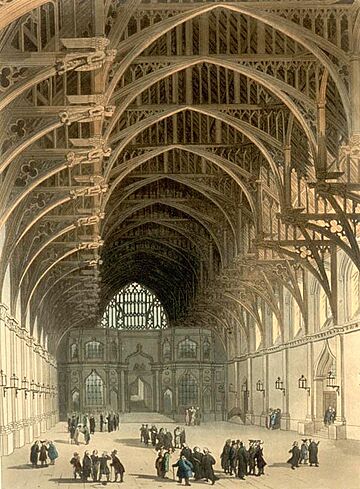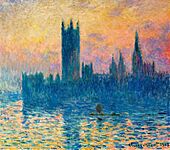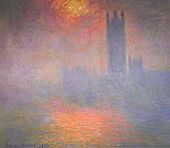Palace of Westminster facts for kids
Quick facts for kids Palace of Westminster |
|
|---|---|
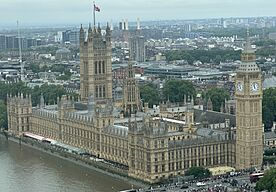 |
|
| General information | |
| Architectural style | Perpendicular Gothic Revival |
| Address | Westminster London SW1A 0AA United Kingdom |
| Coordinates | 51°29′57″N 00°07′29″W / 51.49917°N 0.12472°W |
| Destroyed | 1834 (due to fire) |
| Owner | King Charles III in right of the Crown |
| Technical details | |
| Floor area | 112,476 m2 (1,210,680 sq ft) |
| Design and construction | |
| Architect | Charles Barry and Augustus Pugin |
| Official name | Palace of Westminster, Westminster Abbey, and St Margaret's Church |
| Type | Cultural |
| Criteria | i, ii, iv |
| Designated | 1987 (11th session) |
| Reference no. | 426 |
| Country | United Kingdom |
| Region | Europe |
| Extensions | 2008 |
|
Listed Building – Grade I
|
|
| Official name | Houses of Parliament and The Palace of Westminster |
| Designated | 5 February 1970 |
| Reference no. | 1226284 |
The Palace of Westminster is a famous building in London, England. It is where the Parliament of the United Kingdom meets. People often call it the Houses of Parliament because it is home to the two main groups of lawmakers: the House of Commons and the House of Lords.
This palace is super important for UK politics. When people say "Westminster," they often mean the UK Parliament or the British Government. The famous clock bell in the Elizabeth Tower, known as Big Ben, is a well-known symbol of London and the UK. The Palace of Westminster has been a special Grade I listed building since 1970. It is also part of a UNESCO World Heritage Site since 1987, which means it's recognized as important worldwide.
The building was first built in the 11th century as a royal palace. It was where the kings of England lived until a fire in 1512 destroyed some royal rooms. The king then moved to a different palace. But the rest of the Palace of Westminster kept being used by the Parliament of England, which had met there since the 13th century. In 1834, a much bigger fire destroyed most of the palace. Luckily, Westminster Hall was saved and became part of the new palace.
The design for the new palace was chosen through a competition. An architect named Charles Barry won with his Gothic Revival style design. Building started in 1840 and took 30 years. The palace has special rooms for the House of Commons, the House of Lords, and the monarch. It covers a huge area of 112,476 square metres (1,210,680 sq ft). After the Second World War, many repairs were needed, including rebuilding the Commons chamber that was destroyed. Even with all the work done, the palace still needs major repairs today.
Contents
Exploring the Palace of Westminster
A Look at the Past
The spot where the Palace of Westminster stands was very important in the Middle Ages. It was right by the River Thames. This area was once called Thorney Island. It might have been used by King Canute as a royal home around 1016. Later, Edward the Confessor built a royal palace here, around the same time he built Westminster Abbey (1045–50). Soon, the area became known as Westminster. The oldest part of the palace that still stands today is Westminster Hall, built during the time of King William II.
The Palace of Westminster was the main home for kings in the late Middle Ages. The first version of Parliament, called the Royal Council, met in Westminster Hall. In 1265, a parliament that included representatives from major towns met here. This was a big step for democracy. Since 1295, almost all English Parliaments, and later all British Parliaments, have met at the Palace.
In 1512, during the reign of Henry VIII, a fire destroyed the king's living areas. Henry VIII then moved his main home to the Palace of Whitehall. But Westminster still officially belonged to the royal family. It was mainly used by the two Houses of Parliament and the royal law courts.
Because it was originally a royal home, the palace didn't have special rooms built just for Parliament. Important ceremonies happened in the Painted Chamber. The House of Lords first met in the Queen's Chamber. In 1801, they moved to a bigger room called the White Chamber. This was because more nobles were joining the House of Lords.
The House of Commons didn't have its own room at first. They sometimes met in Westminster Abbey. Later, they got a permanent home in St Stephen's Chapel, which used to be a royal chapel. Over the years, this chapel was changed a lot to fit the needs of the Commons.
From the 1700s onwards, the Palace of Westminster started to change a lot. Parliament needed more space. Instead of building a whole new palace, more buildings were added. A new front, called the Stone Building, was added between 1755 and 1770. It gave more space for documents and meeting rooms. A new home for the Speaker of the House of Commons was also built.
Between 1824 and 1827, the palace was changed again by John Soane. The old House of Lords chamber, where the Gunpowder Plot happened in 1605, was taken down. This made space for a new Royal Gallery. Soane's changes also included new libraries and law courts. Some people didn't like his new designs because they looked too modern compared to the old Gothic style.
The Great Fire and Rebuilding

On October 16, 1834, a huge fire broke out in the Palace of Westminster. It started when a stove used to burn old wooden tally sticks got too hot. Both Houses of Parliament were destroyed, along with most other buildings. Luckily, Westminster Hall was saved because firefighters worked hard and the wind changed direction. Only a few other parts of the palace survived.
Right after the fire, King William IV offered Buckingham Palace to Parliament. But it wasn't suitable for Parliament's needs, so they said no. People wanted to stay at the Westminster site because of its long history. For a short time, the Painted Chamber and White Chamber were quickly fixed up for the Lords and Commons to use.
In 1835, a competition was held to design the new palace. Many architects submitted ideas. The committee decided the new building should be in either the Gothic or Elizabethan style.
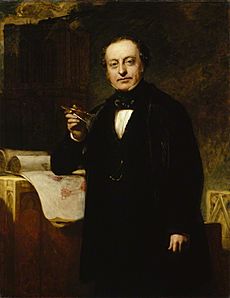
In February 1836, Charles Barry's plan for a Gothic-style palace was chosen. Barry was a classical architect, but he got a lot of help from Augustus Pugin, who was a Gothic expert. Pugin added many of the detailed Gothic features, like the spires and decorations. He also designed much of the beautiful Gothic interiors, including wallpapers, carvings, and stained glass.
Construction began in 1840. The Lords Chamber was finished in 1847, and the Commons Chamber in 1852. Most of the work was done by 1860, but the whole palace wasn't completed until 1870.
Art and Decorations
Once the building was taking shape, people started thinking about the art inside. A special group, led by Prince Albert, decided to fill the walls with paintings. They wanted to encourage British artists and decided the paintings should be frescoes (paintings done on wet plaster).
Many artists submitted their work, but progress was slow. Fresco painting was difficult in England's climate. So, some paintings were done in oil on canvas instead. When Prince Albert died in 1861, the project lost some of its energy. However, many paintings were already finished or being worked on.
Recent Events
During the Second World War, the Palace of Westminster was bombed many times. On September 26, 1940, a bomb damaged the south wall of St Stephen's Porch. The statue of Richard the Lionheart was moved by the blast, and its sword bent. This became a symbol of how strong democracy was, showing it could bend but not break.
The worst attack happened on May 10/11, 1941. An incendiary bomb hit the House of Commons chamber and set it on fire. Another bomb hit the roof of Westminster Hall. Firefighters had to choose which to save, and they decided to save Westminster Hall. The Commons Chamber was destroyed, but Westminster Hall was saved. The Clock Tower was also hit, but the clock kept working accurately.
After the Commons Chamber was destroyed, the House of Lords let the Commons use their debating chamber. The Lords then used the Queen's Robing Room as a temporary meeting place. The Commons Chamber was rebuilt after the war in a simpler style. It was finished in 1950.
As Parliament needed more office space, they started using nearby buildings like the Norman Shaw Building (in 1975) and Portcullis House (in 2000). This means all MPs now have their own offices.
The Palace of Westminster needs a lot of repairs. In 2015, a report said it could cost billions of pounds to fix it if MPs stayed in the building. In 2016, MPs decided to move out for six years starting in 2022 so the work can be done.
The Palace's Outside Look
Charles Barry's design for the Palace of Westminster uses the Perpendicular Gothic style. This style was popular in the 15th century and came back during the Gothic revival in the 1800s. Barry was a classical architect, but Augustus Pugin helped him with the Gothic details. Westminster Hall, which survived the 1834 fire, was included in Barry's new design. Pugin wasn't completely happy with the final look. He said it was "All Grecian, sir; Tudor details on a classic body," meaning it had classical shapes with Gothic decorations.
The Stone Used
In 1839, Charles Barry and a committee looked for the best stone to use. They chose Anston limestone, which is a sand-coloured stone from Yorkshire and Nottinghamshire. It was easy to transport by water and cheaper. It could also be carved easily.
However, the Anston limestone started to decay quickly because of pollution and some poor quality stone. In the 1910s, it became clear that some stone needed to be replaced. In 1928, they decided to use Clipsham stone, a honey-coloured limestone from Rutland. This project started in the 1930s and finished in the 1950s. But by the 1960s, pollution was causing problems again. A big project to restore the stone started in 1981 and finished in 1994.
Famous Towers
The Palace of Westminster has three main towers.
Victoria Tower
The biggest and tallest tower is the Victoria Tower, which is 98.5 metres (323 ft) high. It's at the south-western corner of the palace. Barry wanted it to be a very important part of his design, like a strong castle tower. When it was finished in 1858, it was the tallest non-religious building in the world.
At the bottom of the tower is the Sovereign's Entrance. The monarch uses this entrance when they come to open Parliament. The archway is beautifully decorated with sculptures of Saints George, Andrew, and Patrick, and Queen Victoria. Inside the tower, the Parliamentary Archives store important documents on 8.8 kilometres (5.5 mi) of shelves. These include copies of all laws passed since 1497, and important papers like the original Bill of Rights. At the very top of the tower, a 22-metre (72 ft) flagstaff flies the Royal Standard (the monarch's flag) when the King or Queen is in the palace. On other days, the Union Flag flies.
Elizabeth Tower (Big Ben)
At the north end of the palace is the Elizabeth Tower, usually called Big Ben. It is 96 metres (315 ft) tall, just a bit shorter than the Victoria Tower, but much thinner. It was called the Clock Tower until 2012, when it was renamed to celebrate Elizabeth II's Diamond Jubilee. Augustus Pugin designed the Clock Tower.
The tower holds the Great Clock, which was designed by Edward John Dent and Edmund Beckett Denison. It is very accurate and has been working reliably since 1859. The time is shown on four large dials, each 7 metres (23 ft) across. They are made of glass and light up at night. The hour hand is 2.7 metres (8 ft 10 in) long, and the minute hand is 4.3 metres (14 ft) long.
Five bells hang above the clock. Four smaller bells play the Westminster Chimes every 15 minutes. The biggest bell strikes the hours. This large bell is officially called the "Great Bell," but everyone knows it as Big Ben. The original Big Ben bell cracked during testing and had to be remade. The current bell also has a crack, which gives it a special sound. It weighs 13.8 tonnes (13.6 long tons). At the very top of the Elizabeth Tower is the Ayrton Light. This light turns on when either House of Parliament is meeting after dark. It was put there in 1885 so Queen Victoria could see from Buckingham Palace if the lawmakers were "at work."
Central Tower
The Central Tower is the shortest of the three main towers, at 91 metres (299 ft). It stands in the middle of the building, right above the Central Lobby. It was added to the plans because of Dr. David Boswell Reid, who was in charge of the palace's ventilation. He wanted a central chimney to pull out "bad air" from the building. The tower didn't work well for ventilation, but it made the palace look better. It was designed to balance the look of the two larger towers.
Other Towers
Some other parts of the palace are also called towers. St Stephen's Tower is in the middle of the palace's west side. It's where the public enters the palace. The buildings at the north and south ends of the river front are called Speaker's Tower and Chancellor's Tower. They are named after the leaders of the two Houses. Speaker's Tower holds Speaker's House, which is the official home of the Speaker of the Commons.
Many smaller towers and spires also decorate the palace's skyline. These were also built for practical reasons, like hiding ventilation shafts.
Palace Grounds
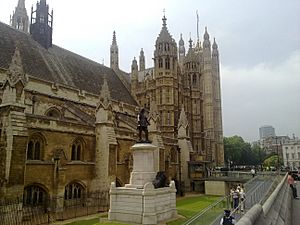
There are several small gardens around the Palace of Westminster. Victoria Tower Gardens is a public park along the river south of the palace. Black Rod's Garden is private and used as an entrance. Old Palace Yard, in front of the palace, has concrete security blocks. Cromwell Green, New Palace Yard, and Speaker's Green are all private. College Green, across from the House of Lords, is a small grassy area often used for TV interviews with politicians.
Inside the Palace
The Palace of Westminster has over 1,100 rooms, 100 staircases, and 4.8 kilometres (3 mi) of hallways. These are spread over four floors. The ground floor has offices, dining rooms, and bars. The first floor holds the main rooms, like the debating chambers, lobbies, and libraries. The top two floors are used for committee rooms and more offices.
Some of the interior designs were created by J. G. Crace, who worked with Pugin. For example, Crace decorated the ceiling of the Chapel of St. Mary Undercroft.
How the Palace is Laid Out
The Palace has different entrances for different groups of people. The Sovereign's Entrance is at the bottom of the Victoria Tower. The monarch uses it for the State Opening of Parliament. This entrance leads to a series of grand rooms used by the monarch, ending at the Lords Chamber. Members of the House of Lords use the Peers' Entrance.
Members of Parliament enter from the Members' Entrance in New Palace Yard. This leads them to the Members' Lobby, just south of the Commons Chamber. The Speaker's House has its own main entrance in the north-east corner.
St Stephen's Entrance is for the public. From here, visitors walk up stairs to St Stephen's Hall. This hall has statues of famous historical figures. Walking through this hall brings visitors to the Central Lobby, which is the heart of the Palace. This octagonal (eight-sided) hall connects to the Lords Chamber to the south and the Commons Chamber to the north. It also leads to the public entrance and libraries.
The Monarch's Rooms
Norman Porch
The Sovereign's Entrance is under the Victoria Tower. It's used by the monarch and important visitors. From the entrance, a grand staircase leads up to the Norman Porch. This square room was meant to have statues of Norman kings and paintings of Norman history, but these were never finished. Today, it has stained glass windows and busts of prime ministers.
Robing Room
The Robing Room is where the monarch gets ready for the State Opening of Parliament. They change into their official robes and put on the Imperial State Crown here. The main feature is the chair of state, which sits on a raised platform. The room is decorated with scenes from the legend of King Arthur, which Victorians saw as a symbol of their nation. Five large paintings by William Dyce show stories from the legend. There are also carvings and a frieze (a band of decoration) showing coats of arms of the Knights of the Round Table.
During World War II, the Robing Room was used as the House of Lords' meeting room when the Commons Chamber was destroyed.
Royal Gallery
The Royal Gallery is one of the largest rooms in the palace, measuring 33.5 by 13.7 metres (110 by 45 ft). Its main use is for the royal procession during the State Opening of Parliament. Important guests watch the procession from here. It's also used for special events, like when foreign leaders speak to Parliament.
The walls were meant to show important moments in British military history. Two large paintings by Daniel Maclise show The Death of Nelson and The Meeting of Wellington and Blücher after the Battle of Waterloo. Sadly, these paintings have faded a lot over time. The rest of the walls have portraits of kings and queens. There are also eight gilded statues of monarchs who ruled during important battles.
Prince's Chamber
The Prince's Chamber is a small room between the Royal Gallery and the Lords Chamber. Members of the House of Lords often meet here to talk informally. The room's theme is Tudor history. There are 28 oil portraits of members of the Tudor dynasty and 12 bronze carvings showing scenes like The Field of the Cloth of Gold.
The room also has a large statue of Queen Victoria, sitting on a throne. She holds a scepter and a laurel crown, showing her power. Two other statues, Justice and Clemency, stand beside her. This group of statues reminds the monarch of their duties.
Lords Chamber
The House of Lords Chamber is in the southern part of the palace. It is a richly decorated room, 13.7 by 24.4 metres (45 by 80 ft). The benches and furniture in the Lords' area are red. The upper part of the room has stained glass windows and six paintings showing religion, chivalry, and law.
At the south end is the gold Canopy and Throne. The monarch sits here only for the State Opening of Parliament. In front of the Throne is the Woolsack, a red cushion filled with wool. It represents the historical importance of the wool trade. The person leading the House, called the Lord Speaker, sits on the Woolsack. The House's mace, a symbol of royal power, rests on the Woolsack.
Members of the House sit on red benches on three sides. Government members sit on the right, and opposition members sit on the left. Some members, called crossbenchers, don't belong to any party and sit in the middle.
The Lords Chamber is where important ceremonies happen, like the State Opening of Parliament. This ceremony officially starts each new parliamentary year. The King or Queen sits on the Throne and gives a speech outlining the government's plans. Members of the House of Commons are not allowed on the Lords' debating floor. They watch from just inside the door.
After the Commons Chamber was destroyed in World War II, the Lords' chamber was used by the Commons. The Lords temporarily used the Robing Room. You can still see damage on one of the doors where Black Rod struck it.
Peers' Lobby
Just north of the Lords Chamber is the Peers' Lobby. This is where Lords can talk informally during meetings. It's a square room, 12 metres (39 ft) on each side. A beautiful Tudor rose made of marble is in the center of the floor. The walls have carvings representing the six royal families that ruled England.
The doorway to the Lords Chamber is very grand. It has brass gates that weigh 1.5 tonnes. Other doors lead to corridors and offices. The Peers' Corridor is decorated with eight paintings by Charles West Cope. These paintings show historical scenes from the English Civil War and represent how national freedoms were won.
Central Lobby
The Central Lobby is the heart of the Palace of Westminster. It's right under the Central Tower. It's a busy meeting point between the House of Lords to the south and the House of Commons to the north. Visitors enter here from St Stephen's Hall. People can meet their Members of Parliament here, which is where the term lobbying comes from.
The Central Lobby is 18 metres (59 ft) across and 23 metres (75 ft) high. The ceiling is decorated with mosaics of flowers and symbols. Each wall has an arch with statues of English and Scottish monarchs. Above the doorways are mosaics of the patron saints of the UK: Saint George for England, Saint Andrew for Scotland, Saint David for Wales, and Saint Patrick for Ireland. Four large statues of 19th-century statesmen stand in the lobby, including William Gladstone. The floor has intricate patterns and a Latin phrase from Psalm 127, which means: "Unless the Lord builds the House, those who build it labor in vain."
The East Corridor, leading from the Central Lobby, has six paintings showing scenes from Tudor history. These include a famous scene from Shakespeare's play Henry VI, Part 1, showing the origin of the red and white roses as symbols of the Houses of Lancaster and York.
Members' Lobby

North of the Central Lobby is the Commons' Corridor, which leads to the Members' Lobby. This room is where Members of Parliament (MPs) have discussions and are often interviewed by journalists.
The Members' Lobby is similar to the Peers' Lobby but simpler. It was rebuilt after being badly damaged in the 1941 bombing. The archway leading to the Commons Chamber was left unrepaired as a reminder of the war. It's now called the Rubble Arch or Churchill Arch. Statues of Winston Churchill and David Lloyd George stand on either side. Many MPs rub their feet for good luck before giving their first speech. The Lobby also has busts and statues of most 20th-century prime ministers.
Commons Chamber
The House of Commons Chamber is at the northern end of the Palace. It was opened in 1950 after the original chamber was destroyed in 1941. The room is 14 by 20.7 metres (46 by 68 ft) and is simpler than the Lords Chamber. The benches and furniture in the Commons are green. Many other countries in the Commonwealth have copied this color scheme, with green for the lower house and red for the upper house.
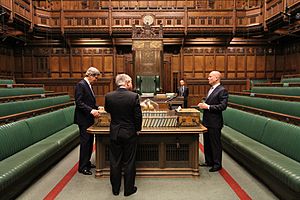
At the north end is the Speaker's Chair, which was a gift from Australia. In front of the Speaker's Chair is the Table of the House, where the clerks sit and the Commons' ceremonial mace is placed. The dispatch boxes, which MPs lean on during speeches, were a gift from New Zealand.
Government MPs sit on the Speaker's right, and opposition MPs sit on the Speaker's left. The Chamber is quite small and can only fit 427 of the 650 MPs. During important debates, many MPs have to stand.
By tradition, the British monarch does not enter the Commons Chamber. The last monarch to do so was King Charles I in 1642. He tried to arrest five MPs. Since then, when Black Rod (representing the monarch) comes to summon the Commons to the Lords, the doors to the Commons Chamber are slammed shut in their face. Black Rod must then knock three times to be let in.
There are two red lines on the floor of the House of Commons, 2.5 metres (8 ft 2 in) apart. It's said this distance is just over two sword-lengths, to prevent fights. MPs are not allowed to cross these lines when speaking.
Westminster Hall
Westminster Hall is a very old medieval hall and the oldest part of the palace that still stands. It was built in 1097 for William II. At that time, it was the largest hall in Europe. It has been used for many things, including law courts for centuries. Sometimes, when both Houses of Parliament meet together, they use this hall. It was also used for coronation banquets and for important people to lie in state after their death.
The hall is famous for its hammerbeam roof, which is a special type of wooden roof. This roof was built for Richard II in 1393. It is the largest clear-span medieval roof in England, measuring 20.7 by 73.2 metres (68 by 240 ft). The oak wood came from forests far away. At the same time, the walls were refaced, and 15 life-size statues of kings were added.
Other Rooms
The Palace of Westminster also has two sets of libraries for the House of Lords Library and House of Commons Library. These libraries overlook the river.
The Speaker of the House of Commons and the Lord Chancellor (leader of the House of Lords) have official apartments in the palace. Each day, they take part in formal processions from their homes to their chambers.
The palace also has many bars, cafeterias, and restaurants. There's even a gym and a hair salon! Parliament also has two souvenir shops where you can buy items like key-rings and china with the House of Commons logo.
Keeping the Palace Safe
The Lady Usher of the Black Rod is in charge of security for the House of Lords. The Serjeant at Arms does the same for the House of Commons. However, the main security is handled by the Parliamentary Security Director and a special police force. Only the Serjeant at Arms is allowed to carry a sword inside the Commons chamber.
To prevent car bomb attacks, concrete blocks were placed in the roadway in 2003. On the river, boats are not allowed within 70 metres (77 yd) of the bank without permission.
Visitors can still go to the Strangers' Gallery in the House of Commons to watch debates. Everyone who enters must go through metal detectors and have their bags scanned. Police officers are always on duty around the palace.
Past Incidents
The famous Gunpowder Plot of 1605 was a plan to blow up the House of Lords. A group of Roman Catholics wanted to kill King James I and replace him with a Catholic monarch. They placed a lot of gunpowder under the House of Lords. But the plot was discovered, and the conspirators were arrested. Since then, the cellars of the palace are searched by the Yeomen of the Guard before every State Opening of Parliament.
The previous Palace of Westminster was also where Prime Minister Spencer Perceval was shot and killed in 1812. He is the only British Prime Minister to have been assassinated.
The new palace was attacked by bombs in 1885. One bomb exploded near St Stephen's Chapel, damaging the roof and shattering windows. Another bomb exploded in the Commons Chamber, causing a lot of damage but no injuries.
On June 17, 1974, a 9-kilogram (20 lb) bomb exploded in Westminster Hall. It injured 11 people and caused a lot of damage. Five years later, in 1979, a car bomb killed Airey Neave, a politician, in the Commons car park.
The palace has also seen many protests. In 1970, someone threw tear gas into the Commons Chamber. In 2004, protesters threw flour bombs at Prime Minister Tony Blair. Later that year, five protesters ran into the Commons Chamber to protest fox hunting. Because of these events, a glass screen was put up in the Strangers' Gallery, and rules for visitors were made stricter.
Culture and Visitors
The outside of the Palace of Westminster, especially the Elizabeth Tower (Big Ben), is famous worldwide. It's one of London's most visited places. The United Nations Educational, Scientific and Cultural Organization (UNESCO) has named the Palace of Westminster, along with Westminster Abbey and St Margaret's, a World Heritage Site.
You can visit the palace in several ways. UK residents can get tickets from an MP or a Lord to sit in the viewing galleries of the House of Commons or House of Lords. Anyone can also queue for admission when Parliament is meeting, but space is limited. You can also watch committee meetings. If you want to do research, you can visit the Parliamentary Archives.
Free guided tours are available for UK residents during parliamentary sessions. These tours last about 75 minutes and include the state rooms, the chambers, and Westminster Hall. Paid tours are available for everyone during the summer holidays and on Saturdays.
The nearest London Underground station is Westminster, on the District, Circle, and Jubilee lines.
In 2015, Parliament held a year-long event called "Parliament in the Making" to celebrate the 800th anniversary of Magna Carta and the 750th anniversary of the first representative parliament.
See also
 In Spanish: Palacio de Westminster para niños
In Spanish: Palacio de Westminster para niños



